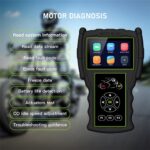Determining whether your 1994 Corvette is OBD2 compliant and diagnosing scan tool communication problems can be frustrating. While the 1996 model year is widely recognized as the start of mandatory OBD2 implementation, the situation with the 1994 Corvette is slightly nuanced. It’s essential to understand the diagnostic system of your C4 Corvette to effectively troubleshoot any issues.
Many owners find themselves asking “Is 1994 Corvette Obd2?” when they encounter difficulties using modern scan tools. The reality is that the 1994 Corvette utilizes an OBD1.5 system, which is a transitional phase between OBD1 and the fully standardized OBD2. This hybrid system employs a 16-pin Diagnostic Link Connector (DLC) – the same physical connector used for OBD2 – but it does not fully adhere to the OBD2 communication protocols.
Alt text: Location of the OBD2 style diagnostic port on a 1994 Chevrolet Corvette C4.
Because of this OBD1.5 designation, a standard OBD2 scan tool may not reliably communicate with your 1994 Corvette. This is often the first hurdle owners face. Before assuming a deeper communication problem, ensure you are using a scan tool that is specifically designed to read OBD1.5 or is backward-compatible with early OBD systems, including those used in the 1994 Corvette. Some advanced scan tools are capable of handling both OBD1.5 and OBD2 protocols, but compatibility should always be verified.
If you’ve confirmed that your scan tool is compatible with the 1994 Corvette’s diagnostic system and are still experiencing communication issues, then a deeper investigation into potential communication problems is warranted. Beyond scan tool compatibility, several factors within your vehicle’s electronic system can prevent successful communication.
A crucial step in diagnosing communication issues is to consult your Corvette’s Factory Service Manual (FSM). The FSM will provide detailed schematics and component locations, essential for tracing circuits and understanding the communication network. Start by identifying the various electronic modules within your Corvette’s system. Ensure that all relevant modules are receiving proper power and ground. A lack of power or a faulty ground connection to even a single module can disrupt communication across the entire system.
In many vehicles of this era, a central gateway module facilitates communication between different modules and the diagnostic port. In older General Motors vehicles, including the C4 Corvette, the Central Control Module (CCM) often serves this gateway function. Locate the CCM based on your FSM and verify that it is powered and grounded correctly. If the CCM is malfunctioning or not communicating, it can effectively block communication with other modules and prevent your scan tool from accessing vehicle data.
Alt text: Diagram showing the Central Control Module (CCM) location in a Chevrolet Corvette C4, relevant for OBD2 diagnostic troubleshooting.
Once power and ground to the modules are verified, the next step involves inspecting the communication wiring itself. Using the wiring diagrams in your FSM, trace the communication wires between the DLC, the CCM (or gateway module), and other relevant modules. Look for any signs of damage, corrosion, or breaks in the wiring. Perform resistance checks on the communication wires to ensure their integrity and rule out any open circuits or shorts.
While less common, modules themselves can sometimes enter a state where they are unresponsive to communication requests. In rare cases, as highlighted by experiences with other vehicle modules like the APIM in Ford vehicles, a module might require a specific “wake-up” signal or a self-test procedure to re-establish communication. However, for the 1994 Corvette, focusing on scan tool compatibility, power, ground, and wiring integrity are typically the most fruitful troubleshooting steps.
In conclusion, while the 1994 Corvette uses an OBD2-style connector, it operates on an OBD1.5 system. Therefore, confirming scan tool compatibility is the primary first step. If communication issues persist with a compatible tool, systematically checking module power, ground, and communication wiring, guided by the Factory Service Manual, will be crucial in diagnosing and resolving the problem. Troubleshooting these communication issues can be complex, but methodical diagnostics will lead to a solution and get you back to enjoying your Corvette.
